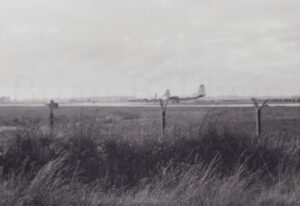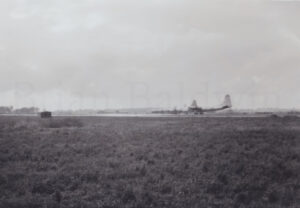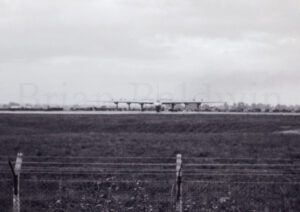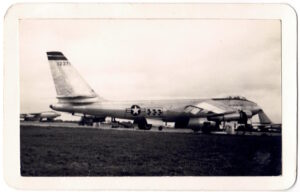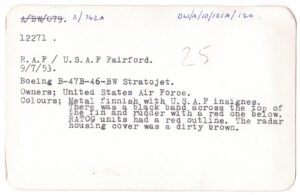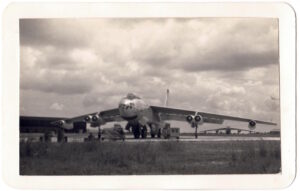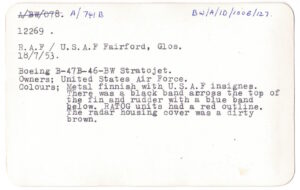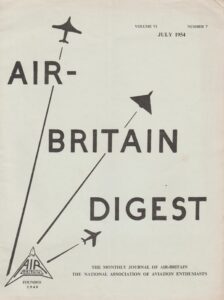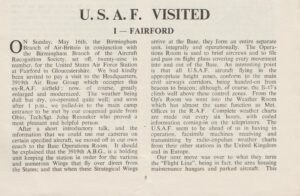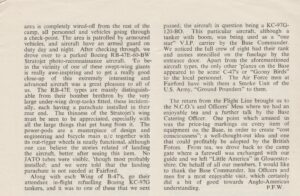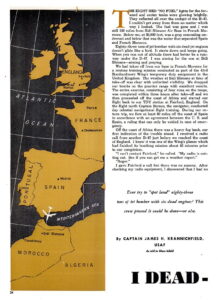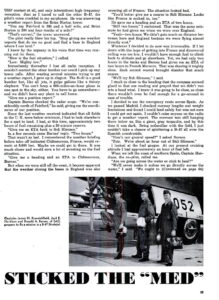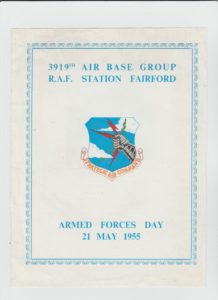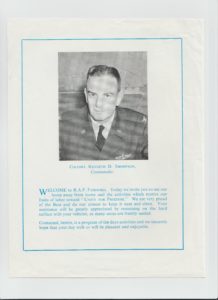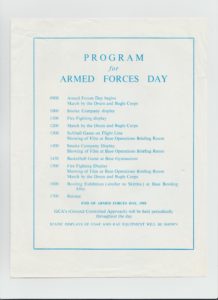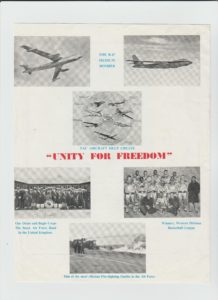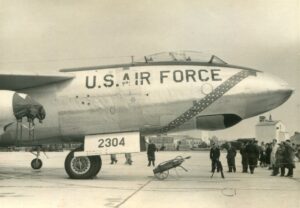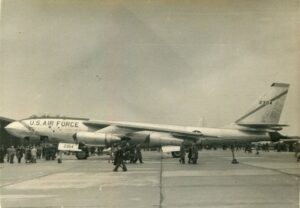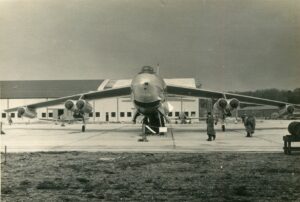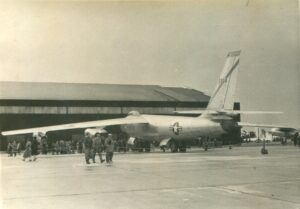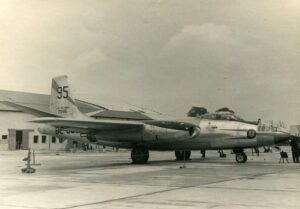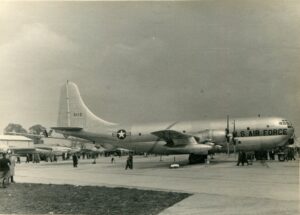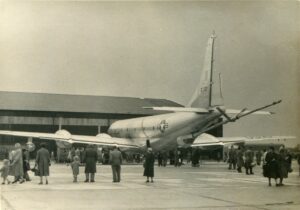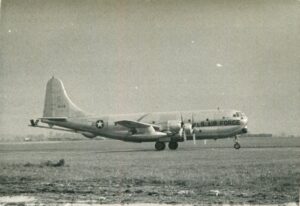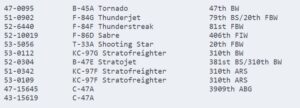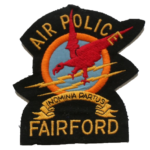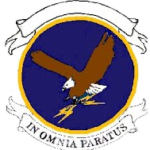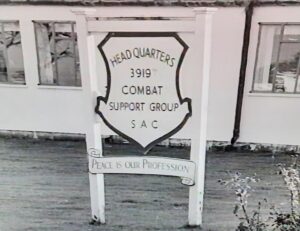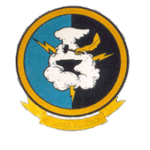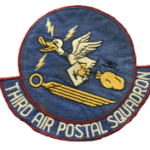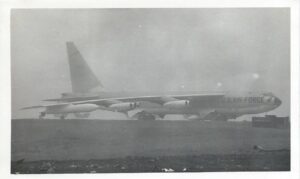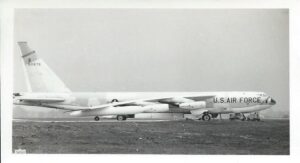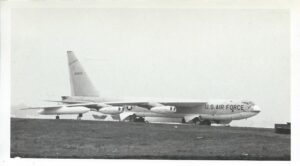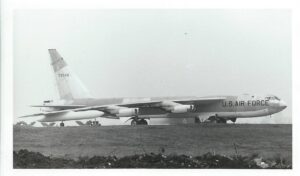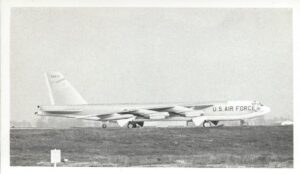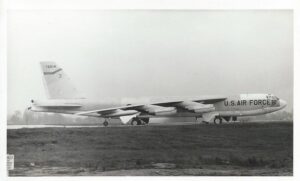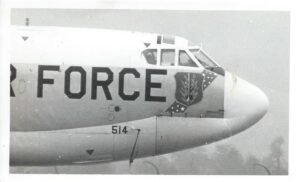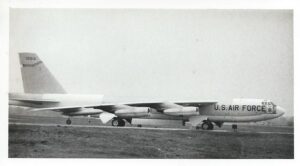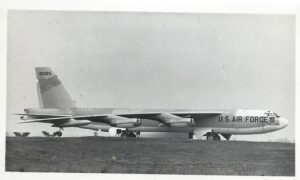USSR Overflight by an RB-47E on May 8th 1954, now available here Overflight
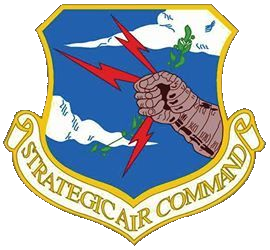
These three photo’s of B-36’s at RAF Fairford were taken by Brian Baldwin in the early 1950’s. Because only 3 aircrafts are visible it’s possible they were ‘Roundout’ RB-36F or RB-36H models from the period September 1952 – May 1953 or May-August 1954 (thanks to Darren Currie for scanning the images)
1950
June – 21st: RAF Fairford was removed from Care & Maintenance status. HQ 3 Group RAF Bomber Command assumed formal operational control. Reconstruction was managed by USAF’s 3rd Air Division at South Ruislip
July – 7th: Fairford’s first local unit was the 7507th Air Base Squadron (ABS), subordinate to the 7503rd Air Base Group (ABG) at Brize Norton
29th: The first elements of the US Army’s 817th Engineer Aviation Battalion (EAB) arrived by sea and rail (the 817th EAB was subordinate to the 928th Engineer Aviation Group at Brize Norton)
Aug – Mid August the runway was described as being under construction to a length of 8000ft (with 1,000ft over-runs at each end) and a width of 150ft.
Sep – 25: The first movement may have been that of a USAF C-47 Skytrain which mistook Fairford for Brize Norton and landed in error
Dec – Following a visit by the Commander of the 93rd BW at Castle AFB, CA on 28th December 1950 (the unit was temporarily headquartered at Mildenhall at the time), nine 328th Bomb Squadron (BS) B-50D’s arrived from Marham on 30th December and they remained at Fairford until 4th January 1951. Ground station control for these aircraft was provided by a unit temporarily established inside a C-47!
1951
May – 3rd: 7507th Air Base Squadron was upgraded to Group status, becoming the 7507th Air Base Group. SAC’s 2nd Aviation Field Depot Squadron (AFDS) was established at Fairford on 19th May to undertake special weapons handling activities.
July – 1st: Formal transfer from the RAF to the USAF
1952
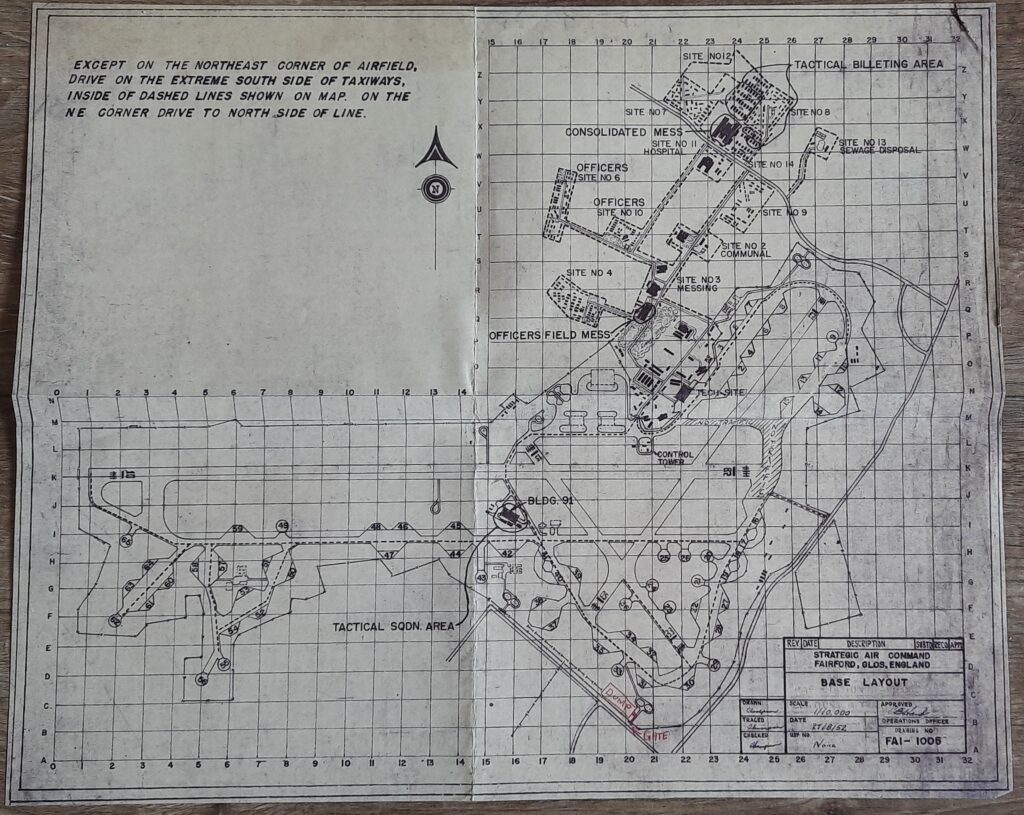
September – 2nd: The 28th Strategic Reconnaissance Wing (SRW) deployed four RB-36H’s to Fairford from Rapid City (now Ellsworth) AFB. Between three and six were maintained on station until about 8th December with varying temporary duty (TDY) periods. This detachment engaged in the photo and radar mapping of Western Europe (Operation Roundabout).
Deployed aircrafts carried “Triangle S” tail Markings – known serials:![]()
28th SRW RB-36H 51-5744 from Fairford visited St Mawgan for a planned mission on the 20th September to carry out necessary checks for the airfield to be used as a staging and post-strike station by the USAF. This coincided with the station’s Battle of Britain celebrations in September 1952.
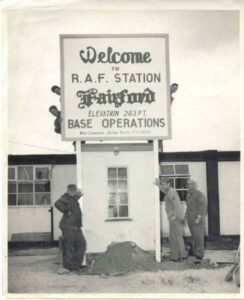
Welcome to R.A.F. Station Fairford
Date unknown but the base Commander is down as Col Jerome Tarter who served Sept 1952 to April 1955
October – 16th October 1952 the 3919th Air Base Group was formed utilising personnel from the 7507th Air Base Group. Concurrently, RAF Fairford came under the control of Headquarters 7th Air Division, Strategic Air Command (SAC) located at Ruislip, England.
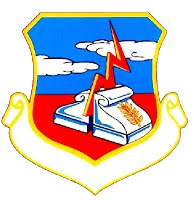
Nov – Thanksgiving meal 27th November 1952, 3919th Air Base Group
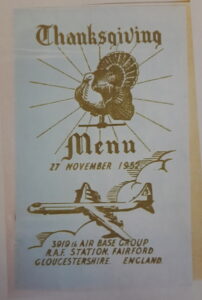
Dec – The 28th SRW RB-36Fs departed on the 8th Dec, replaced by four 5th SRW (Travis AFB) RB-36Fs on the 12th December. This number dwindled to only two after mid-January 1953
“Circle X” fin markings were probably still in use – known serials:![]()
1953
Feb – 6th – 14th: The 7th BW deployed 17 B-36H’s from Carswell AFB, TX to Fairford as part of ‘Operation Styleshow’, most of which arrived early on the 7th. Early morning fog and inadequate Ground Controlled Approach (GCA) facilities forced the diversion of five aircraft to Brize Norton.
Some of the aircraft were still wearing “Triangle J” tail markings. Those marked * were the B-36H’s which diverted to Brize Norton on arrival.
Mar – The 5th SRW RB-36Fs departed on the 12th March, replaced by RB-36Hs from the 28th SRW on the 20th March. This was Fairford’s final ‘Roundabout’ deployment. The first two aircraft arrived circa 20th March but the detachment was transferred to Lakenheath on 23rd April, probably to enable work to be undertaken on the runway prior to the arrival of the first B-47’s.
Some of the aircraft may still have carried “Triangle S” tail markings – known serials:![]()
Apr – Colonel Michael N W McCoy, the flamboyant commander of the 306th BW, led an initial pair of B-47Bs from MacDill AFB to RAF Fairford. McCoy and Capt. George Birdsong piloted one aircraft while Lloyd Griffin and 368th BS C. O. Benny Close flew the other. Departing 6th April 1953, they stopped at Limestone AFB for refueling, and then proceeded to England, setting an unofficial speed record of 553.8mph (891kmh) en route. The two airplanes did not reach RAF Fairford, however, diverting to RAF Brize Norton on 7th April when the crews’ anti-exposure suits caused hyperthermia. Serving as ‘pathfinders’, they came ahead of the first full deployments of B-47s. To assess its suitability to handle B-47s, both of them (escorted by RAF Meteors) made a midday call at Lakenheath on 13 April. What McCoy found was problematic. The runway at RAF Fairford was indeed the requisite 10,000ft (3,048m) in length but had no overruns. Lines were hastily painted 100ft (30.5m) from each end of the runway to create these overruns, which reduced the overall length to 9,800ft (2,987m) with resulting penalties in fuel load and takeoff performance. McCoy returned to Florida on 21st April to oversee final preparations for the deployment.
A book titled ‘B-47 Stratojet’ by Jan Tegler contains a first-hand account of the visit to Fairford by the pair of 306th BW B-47B’s on the 6th April 1953. Col Mike McCoy’s co-pilot (George “Buzz” Birdsong, squadron commander of the 369th BS) tells us that the navigator mistook Brize Norton for Fairford and they actually landed there as the error was realised. Birdsong notes that the 43rs BW B-50A’s helped convince them of their mistake! McCoy apparently turned the landing into an unauthorised ‘roller’ and departed rapidly for Gloucestershire. The second aircraft, crewed by the commanders of the 367th BS and 368th BS, held off and allowed McCoy’s aircraft to make the first landing at Fairford. Birdsong notes that McCoy’s problem flight-suit was indeed troubling him to the extent that he (Birdsong) carried out the landing at Fairford and McCoy actually took a knife to the suit and cut half of it off.
Jun – Colonel Michael N W McCoy led the full Wing’s (306th BW) deployment to RAF Fairford, with 45 B-47Bs departing MacDill AFB in three equal waves on 2nd, 3rd, and 4th June. Some 22 KC-97Es from the 306th AREFS deployed to EA Harmon AFB where they could refuel any en route B-47 in case of emergency, but no air refueling was otherwise planned for the trip to England. Each B-47 routed through Limestone AFB (later renamed Loring), with 15 reaching RAF Fairford on 4th June, 12 on 5th, 16 on the 6th and the final two stragglers arrived on the 7th of June. The 367th, 368th and 369th Bomb Squadrons of the 306th BW spent the following 12 weeks at Fairford as the first B-47 equipped wing to rotate to Britain. Assisting the B-47s throughout their stay was the 306th ARS whose 20 KC-97Es occupied Mildenhall.
The B-47B’s deployed were:
This photograph was taken on the 9th July 1953 of B-47B 51-2271 367th BS at RAF Fairford
This photograph was taken on the 18th July 1953 of B-47B 51-2269 369th BS at RAF Fairford
On 29th – 30th June, the Wing took part in Operation BIG LEAGUE, designed to test the wing’s capability against continental targets. Results were poor, largely due to weather, resulting in additional training missions in July, producing the desired results during a simulated EWP mission flown on 16th July. All 44 planned launches took place, with 40 sorties ‘effective’ over the target. The following week the unit flew Exercise WORLD SERIES with similar results.
Among other aircraft which supported the deployment were a C-54 (272721), a C-97 and two C-47s (224172 and 348774). The choice of the 306th BW was not coincidental, for the unit had been developing combat procedures and flying techniques for the entire B-47 force.
The B-47’s highly publicized trip to the UK received General Curtis E LeMay (SAC’s Commanding General) personal attention while visiting England from 13th May through 16th June, followed by Vice Commander Major General Thomas S Power who brought in an obsevation team from 24th August through 7th September.
Whilst in Britain they received another B-47 which, on August 4, flew from Goose Bay to Fairford in 4 hours 14 minuets, turned about and flew the 4,450 miles to Tampa in Florida without landing. In so doing it set a record time for crossing the Atlantic and became the first aircraft to make a non-stop Atlantic return flight.
Six of the Wing’s B-47Bs relocated to Nouasseur AB in French Morocco on 12th August under Operation SAFARI to evaluate those facilities.
All of the 306th BW’s jets returned directly to MacDill AFB in three waves departing on 4th (15 jets), 5th (13 jets), and 6th September (19 jets). As they did so, in came three groups each of 15 B-47Bs of the 305th BW, in-flight refuelled by their KC-97G squadron which permitted a non-stop flight from Limestone AFB to Brize Norton, where the first 13 examples arrived on 4 September. Two squadrons lodged there, the third at Fairford. KC-97Gs deployed for the first time and in the hands of the 305 ARS were based at Mildenhall.
This article on the 306th BW B-47 deployment to Fairford in June 1953 was produced in ‘The Aeroplane’ magazine July 10, 1953 edition.
[pdf-embedder url=”https://www.raf-fairford.co.uk/wp-content/uploads/2022/04/The-Aeroplane-July-10-1953.pdf” title=”The Aeroplane July 10 1953″]
1954
Mar / Apr – 303rd BW (Davis-Monthan AFB) B-47Es arrived at Greenham Common in early March, but due to major structural weaknesses on the main runway and some hard standings, the B-47Es were hastily moved (thirteen aircraft moved on the 30th and 31st March). By 3rd April all 43 had nominally made the move although the final ferries were probably made circa 15th April. The 303rd BW re-deployed non-stop to Davis-Monthan in three equal waves on 3rd (359th BS), 4th (358th BS) and 5th June (360th BS)
Aircraft involved were:
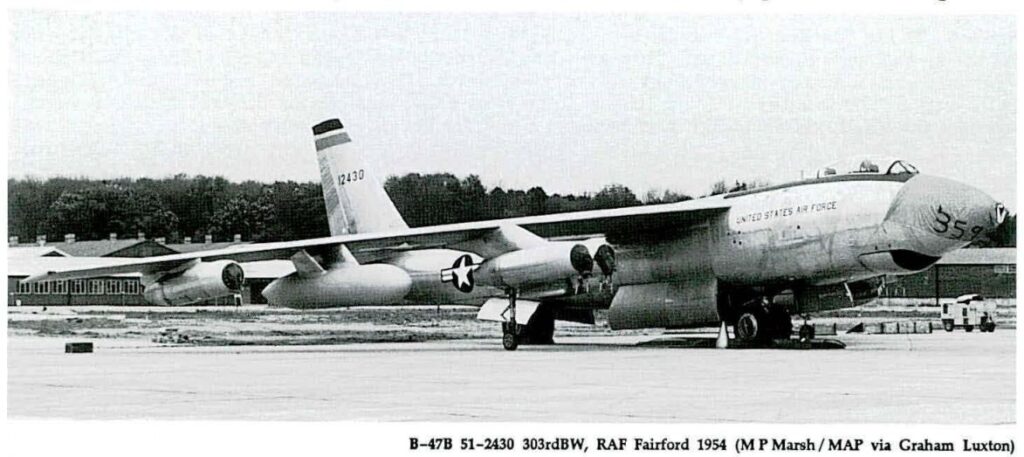
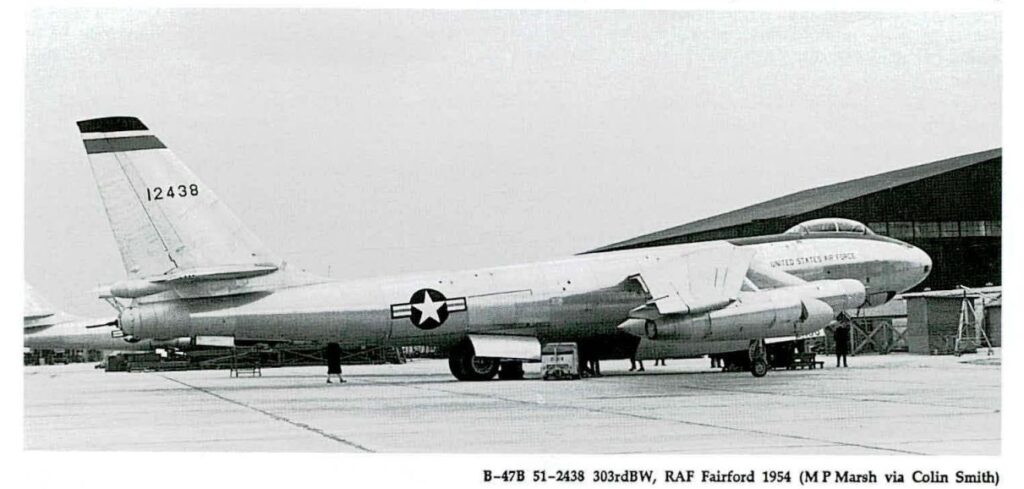
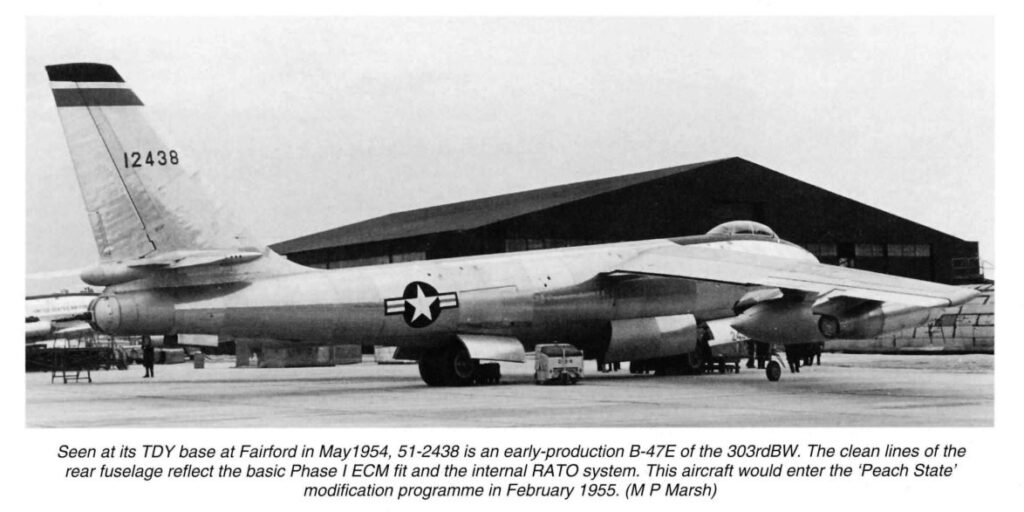
I have created a dedicated page for the USSR Overflight by an RB-47E on May 8th 1954, now available here Overflight
May – Between 3rd and 10th May 1954 42 303rd BW aircraft undertook a Unit Simulated Combat Mission (USCM) to exercise Sidi Slimane, their support tankers going to Wheelus. Features of this exercise were the use of RATO bottles at Sidi Slimane, the use of 20mm tail cannon and 500lb High Explosive (HE) bombs on the Ksar-Es-Souk range. The wing returned to Fairford between the 7th and the 10th May. It had been planned to exchange a squadron of the 44th BW, on TDY at Sidi Slimane from Lake Charles (later renamed Chennault) AFB, LA for one of the 303rds but this was amended to weekly rotations of 44th BW aircraft to Fairford. Commencing 10th May three 44th BW B-47E’s flew to Fairford every Monday and Wednesday, returning home 48 hours later. No serials of the visiting aircraft are known but those on TDY at Sidi Slimane comprised:

The 44th BW redeployed to Lake Charles from Morocco on 15th June 1954.
16th: A Fairford base visit took place by the Birmingham Branch of Air-Britain in conjunction with the Birmingham Branch of the Aircraft Recognition Society. The report was produced in the July 1954 edition of Air-Britain Digest
18th to 20th: Four RB-36H’s from the 28th SRW undertook a three-day mission from Ellsworth AFB to Fairford.
19th: Three 99th SRW RB-36F’s arrived from Fairchild AFB, WA followed by a fourth on 21st May. These aircraft remained until early-July 1954, eventually leaving at intervals between the 1st and 14th. They were replaced by four others which remained until 15th August. Seven of them have been identified although squadron allocations are unknown: ![]()
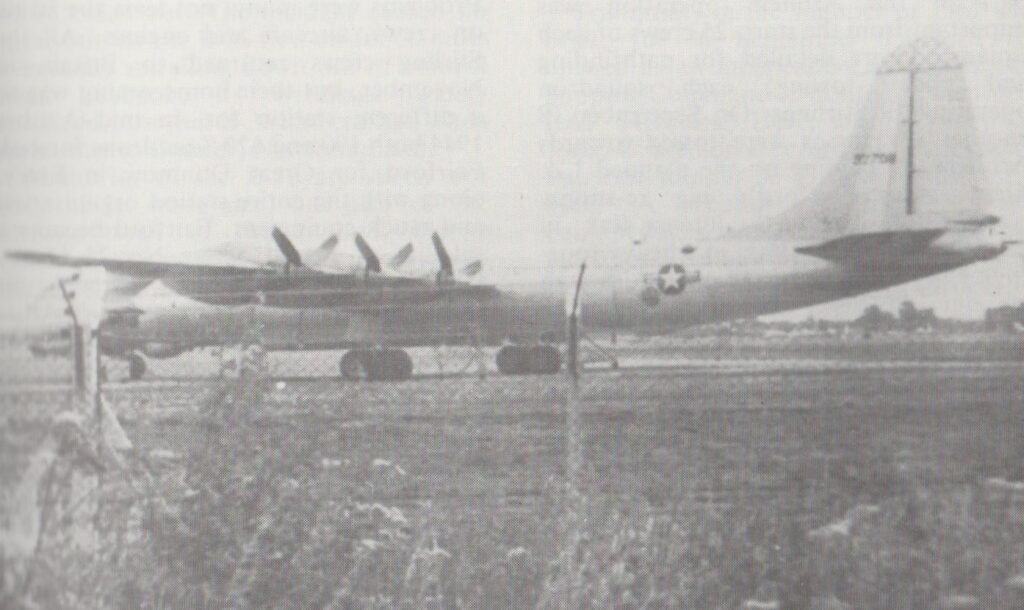
Michael J.F. Bowyer ‘Action Stations 6’
June – 68th BW from Lake Charles AFB, Louisiana deployed 45 B-47E’s to Fairford. Individual aircraft records show fourteen arrivals on each of the 16th, 19th and 20th then three on 21st June. Redeployment took place between 5th and 7th August, although the last pair did not arrive home until 14th August. Individual squadron allocations/markings are not known:
5th Strategic Reconnaissance Wing – A total of 18 RB-36Fs deployed to Fairford and Upper Heyford for a ‘special exercise’ (June to July)
Sept – The 43rd BW, Davis-Monthan AFB deployed 43 B-47E-II jets to Fairford for a 90 day TDY. 38 B-47’s arrived between 5th and 8th September followed by five more on 14th September. The 43rd ARS KC-97Gs going to Lakenheath. 15 aircraft were deployed to Brize Norton between 22nd and 24th September for Exercise ‘Blueplate’.
An interesting article in ‘Flying’ magazine December 1955 on a B-47 flight from Sidi Slimane to RAF Fairford which resulted in the loss of 6 engines and a return to Sidi Slimane (No date was mentioned)
Nov – B-47 Record flight distance and endurance: On 17 November, Colonel David A. Burchinal, Commander of the 43rd BW, took off from Sidi Slimane, French Morocco, in a B-47 and directed his course toward Fairford RAF Station, England, where his wing was on 90-day rotational training. Bad weather prevented him from landing at Fairford, and he returned to French Morocco only to find bad weather at Sidi Slimane. With the assistance of nine inflight refuelings. Colonel Burchinal kept flying until the weather finally cleared at Fairford on 19 November. In the meantime, he had established a distance and endurance jet flying record of 21,163 miles in 47 hours and 35 minutes.
1955
Mar – Post strike exercise ‘Sign Board’ brought up to 30 93rd BW B-47E’s from Castle AFB to Fairford. The first arrivals landing on 1st March and the final departures taking place on 8th March.
Apr – Exercise ‘Bolier Maker’ brought the two wings of Davis-Monthan’s 36th Air Division back to Fairford between 27th April and 3rd May 1955. Each wing (the 43rd BW and the 303rd BW) brought 32 B-47E’s.
May – Fairford’s first and only Armed Forces Day was celebrated on 21st May 1955, two days prior to the deployment of the next TDY unit.
Photos from the Armed Forces Day kindly provided by the ‘RAF Upper Heyford Heritage Collections’
B-47E 52-0304 was on 90-day rotational training at Upper Heyford March to June 1955 with 44 others (Graham Luxton)
KC-97G 53-0112 was on 90-day rotational training with the squadron at Brize Norton, March to June 1955 (Graham Luxton)
According to Scramble.nl the following aircrafts attended the Armed Forces Day
The 9th BW undertook a 45-day TDY from Mountain Home AFB, to Fairford between 23rd May and 11th July 1955. Individual B-47 aircraft records show seven arrivals at Fairford on the 24th, five on the 26th, four on the 27th , thirteen on the 28th, two on the 30th and thirteen on 1st June. One further aircraft arrived, date unknown.
July – The 320th BW deployed to Fairford with it’s 441st, 442nd and 443rd BS along with the 320th 3 Maintenance Squadrons & 320 Tactical Hospital 15 Jul 1955 – 15 Sep 1955 the Wing’s 320th AREFS was deployed to Alaska at the same time and did not go to Fairford
Aug – What is thought to have been Fairford’s final post-strike exercise of 1955 was ‘Billy Club’ which took place in August and involved B-47’s from the 22nd BW and 320th BW, the two wings under the March-based 12th Air Division. Details are regrettably fragmentary but the exercise was a large one with the 7th Air Division records indicating 64 aircraft post-striking between 11th and 14th August. Conflicting references suggest that the first wave of arrivals from the 320th BW reached Fairford on 19th August (perhaps following those of the 22nd BW) and that aborts reduced their numbers to 29 (presumably from 32). The 320th redeployment was scheduled for 1st and 2nd September.
Oct – The 3919th ABG was reconstituted as the 3919th ABS on 15th October
Under the squadron concept the 3919th Air Base Squadron was organised into flights similar in operation to the separate squadrons of a group, e.g. Operations Flight, Supply Flight etc, with a total of ten flights comprising the squadron. Although these flights were an integral part of the squadron for administrative purposes each had its own officer in charge with a Flight Sergeant performing the duties of a First Sergeant.
The 3919th Air Base Squadron operated as a separate organisation under the command of Headquarters 7th Air Division, receiving Supply, Medical, Finance and Legal support from the 3920th Air Base Group at RAF Brize Norton.
15 OCT 1955 – 30 JUN 1962: 3919th Air Police Squadron: Later Re-designated: 3919th Combat Defense Squadron
1956
Feb – February to June, B-47Es, 509th BW (393rd BS, 715th BS, 830th BS)
6th February saw the arrival of a B-47 from Walker, AFB, New Mexico
1957
Mar – Six B-47E’s of the 384th BW from Little Rock AFB, AR exercised the base on 7th March 1957. The wing, on TDY at Brize Norton, flew a major exercised named ‘Fixed Star’ which commenced the previous day. As part of this exercise, two waves of six aircraft were launched on the 7th and, after flying a USCM in conjunction with some 100th ARS tankers on TDY at Greenham Common from Portsmouth AFB, NH, the two waves post-striked at Fairford and Chelveston, arriving in the early hours (one of Fairford’s aircraft diverted to Brize Norton due to poor weather).
June – The next exercise took place on 12th June during ‘Bride Groom’ when 12 B-47E-IV’s from the 380th BW at Plattsburgh AFB (TDY at Brize Norton) were post-strike handled.
July – The 40th BW from Schilling AFB, KS (TDY at Greenham Common), briefly exercised Fairford during the course of it’s evaluation mission ‘Looking Glass’. flown between 5th and 16th July. Thirteen B-47E-IV’s were due to post-strike through the base on 8th July but in the event five of them diverted to Greenham Common. The eight which landed were each on the ground for about 90 minutes during the afternoon.
Nov – Fairford’s final exercise of the pre ‘Reflex’ era was it’s participation in ‘Iron Bar’. Flown between 25th November and 10th December, it involved the RB/B-47’s of the 26th SRW, 68th BW (on TDY at Brize Norton), 321st BW, 340th BW and 341st BW along with the KC-97’s of the 310th ARS and 376th ARS (on TDY at Ben Guerir, Morocco but with a detachment at Greenham Common). Fairford supported the 26th SRW from Lackbourne AFB throughout this period and, as far as is known, no other tactical aircraft used the base. The eighteen 26th SRW RB-47E’s were scheduled in from Lockbourne on 26th November but, following a ground abort and an air return only sixteen arrived, the two stragglers turning up the following day. The first two weather missions were flown on 28th November with one aircraft diverting to Lakenheath due to poor weather at Fairford. The 26th SRW’s strike reconnaissance mission was flown by fifteen aircraft on 30th November. On 1st December four of them flew weather sorties while six returned to Lockbourne (two of which diverted, one to Plattsburgh and the other to Thule). Two more weather missions were flown on the both 2nd and 3rd December and another eight aircraft left for Lockbourne (one returned to Fairford with fumes in the cockpit and the others diverted to Plattsburgh due to poor weather at Lockbourne). After weather delays in the UK, four more aircraft returned via Goose Bay on 6th December followed by the last straggler, date unknown.
1958
‘Reflex Action‘ Alert. Commencing on 7th January 1958, SAC’s 2nd and 8th Air Forces each maintained fifteen B-47’s in Britain, each Air Force rotating all fifteen aircraft on a weekly basis. Initially this required participation of six wings to ‘Reflex’ at two bases, Fairford and Greenham Common. Thus, commencing on 7th January, increments of five aircraft from each of the three wings assigned to each base would arrive every Tuesday, Wednesday and Thursday, allowing five departures (commencing on 15th January) to take place every Wednesday, Thursday and Friday. Fairford known as ‘Wildcat Alpha’ in EWP, thus commenced ‘Reflex’ on 7th January using 2nd Air Force wings, comprising the 2nd BW and 308th BW from Hunter AFB, AL and the 384th BW from Little Rock, AR. The five aircraft from each wing required ten combat-ready crews on station and this increased to fourteen on 15th April.
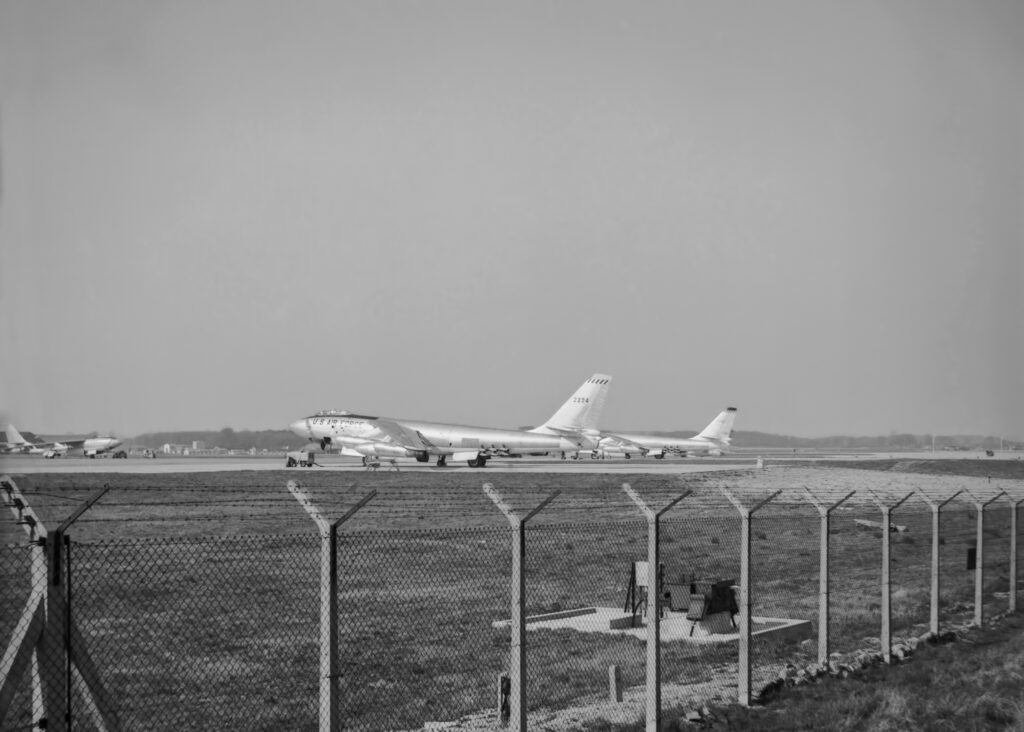
Serials identified 52-224 (384th BW) & 51-7051 (384th BW)
Thanks to Dave Layland and Darren Currie
The Hunter-based wings (i.e. those under the 38th Air Division) deployed to Fairford on ‘Reflex’ only until 6th April when both units were switched to Brize Norton as that base came on line as ‘Wildcat Charlie’.
We have no official records which identify the aircraft dispatched to Fairford but it can be assumed that a very high percentage of those on strength would have made the trip at least once. Aircraft in use during the period were as follows (those noted by enthusiasts are marked ■ here and in subsequent tables):


The 384th BW ‘reflexed’ to Fairford until 30th June 1958 when it transferred its alert posture to Moron AB in Spain (‘Shotgun Foxtrot’). As with the Hunter wings, five aircraft were changed weekly until 17th May when the number of alert machines was increased to six and the number of weekly changes reduced to three.
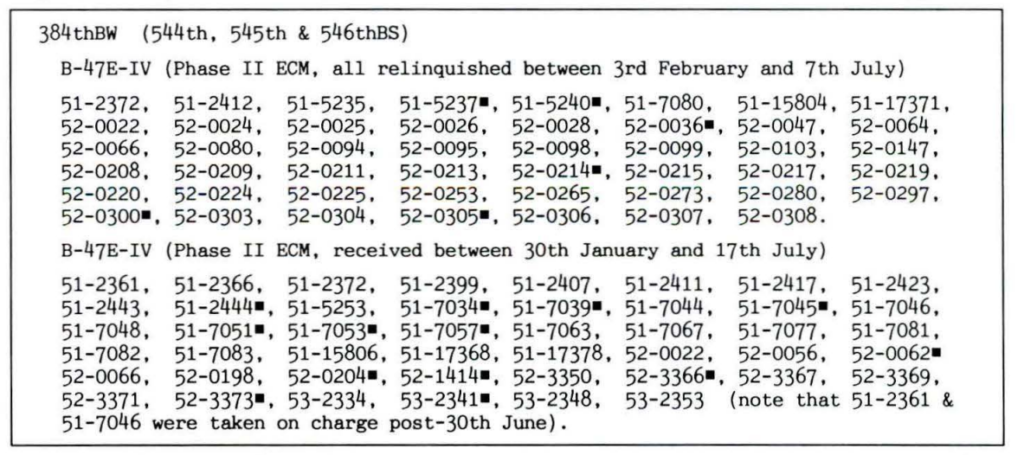
The final major ‘Reflex’ change of 1958 occurred on 1st July when the 384th BW was replaced by the 68th BW from Lake Charles. The six-ship alert force began to arrive from 21st June, eventually allowing the 384th BW aircraft to depart on 1st July (three moved to Moron and three returned to Little Rock). The 68th BW was to continue the Fairford ‘Reflex’ until 31st July 1962 and during those four years several changes took place. The six-ship alert was maintained until late-July 1961, when, in response to the Berlin Crisis of that Summer, it was increased to nine and joined by three 96th BW machines. The nine aircraft alert continued until 31st July 1962 when the 68th BW ‘Reflex’ moved to Sidi Slimane, Morocco.
68th BW aircraft seen at Fairford until the end of Reflex:


![]()
![]()

![]()
During the ‘Reflex’ years Fairford was a quiet and desolate airfield and weekend movements were almost unknown
Oct – 18th: 3919th ABS became 3919th ABG
1959
Jan – The 3919th Combat Support Group (SAC) was re-designated from the 3919th Air Base Group on 1 January 1959 in accordance with SAC General Order 67, dated 16 October 1958. The 3919th CSG was assigned for logistical support to the 3920th Combat Support Group at RAF Brize Norton.
1961
July – The 68thBW maintained its six aircraft ‘Reflex’ alert at Fairford until July 1961 when, in response to increased tensions in Berlin, President Kennedy (on 8th July) instructed the armed forces to increase their conventional military presence in theatre. This was followed by his statement on 23rd July that the accelerated B-47 phase out he had announced on 28th March would be delayed. Thus the inactivation of the 68thBW and the closure of Chennault AFB were both deferred . In response to the crisis the 68thBW increased its Fairford strength to nine aircraft and on 15th July they were joined by a three ship alert force from the 96thBW at Dyess AFB, TX. The 96thBW had already been maintaining a six aircraft ‘Reflex’ alert at Greenham Common since 28th March and this continued after the Fairford alert was established. The 96th thus rotated one Fairford aircraft and two Greenham Common aircraft each week. This arrangement was maintained until 31st July 1962 when the three ship alert at Fairford was transferred to Greenham. Aircraft on strength over his period were:

1962
Apr – The 96th BW was retitled as the Strategic Aerospace Wing (SAW) on 1st April 1962.
Aug – The 68th BW and the 96th SAW were replaced at Fairford by the 340th BW from Whiteman AFB, MO and the latter unit’s aircraft began to appear in late-July 1962. It is assumed that formal alert for the new wing commenced on 1st August, the last 68th BW and 96th SAW aircraft having left the previous day. Twelve 340th BW B-47E’s stood the alert until 30th June 1963 with four aircraft changing each week.

Oct – Cuban Missile Crisis: US President J F Kennedy brought the US forces to a Defence Condition (DEFCON) Two alert state on 22nd October 1962 and, effective immediately, the ‘Reflex ‘ pattern changed. When previously practised, such a condition had meant that the regular rotations ceased for the duration of the exercise (typically a week) but now, not only were all aircraft held at the overseas bases, but additional machines were deployed to bring the ‘Reflex’ forces to EWP strength. At Fairford the 340thBW returned two B-47E’s to Whiteman at the beginning of the alert and replaced them with four to bring the alert strength to fourteen aircraft. In common with several other wings, the 340thBW was a recipient of a 4347thCCTW machine as training crews stepped up into combat wings. The alert remained in place until circa 29th November when the regular rotations resumed. At no time during the alert did any Fairford (or any other 7th Air Division) combat aircraft leave the ground. The Division’s normal flying programme recommenced on 7th December and Fairford’s twelve-ship alert force was re-instated.
Dec – The 19th ARS from Otis AFB, MA undertook the Fairford tanker alert from circa 16th December 1962 until circa 31st December 1963 with each aircraft TDY lasting about 28 days.
On 1st December, 1962 a SAC Alert Reflex posture was implemented at Fairford and this was supported by a KC-97. This was used to airlift B-52 start teams, the aircraft being from the 19th Air Refuelling Squadron, Otis AFB, Mass. and was on alert at Fairford for twenty-eight days at a time. (Colin E. Wilks – SEAR)
1963
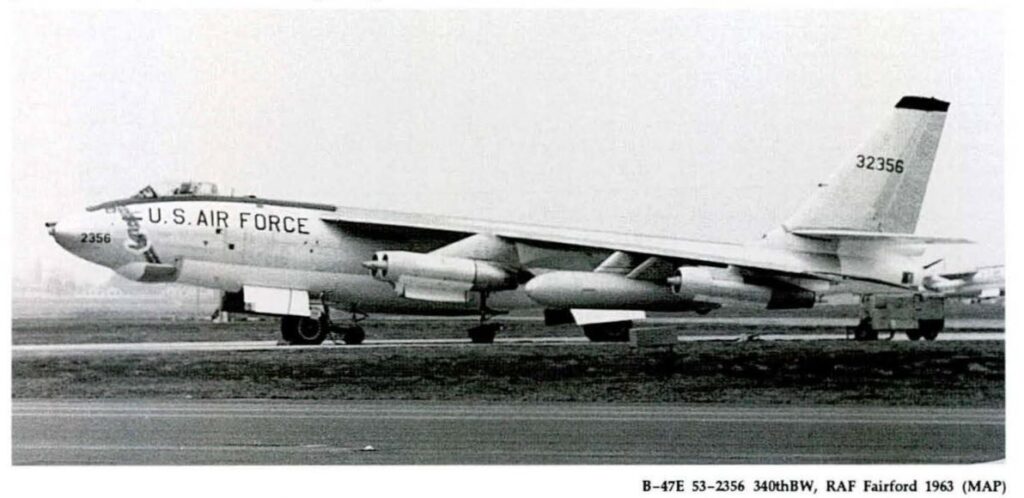
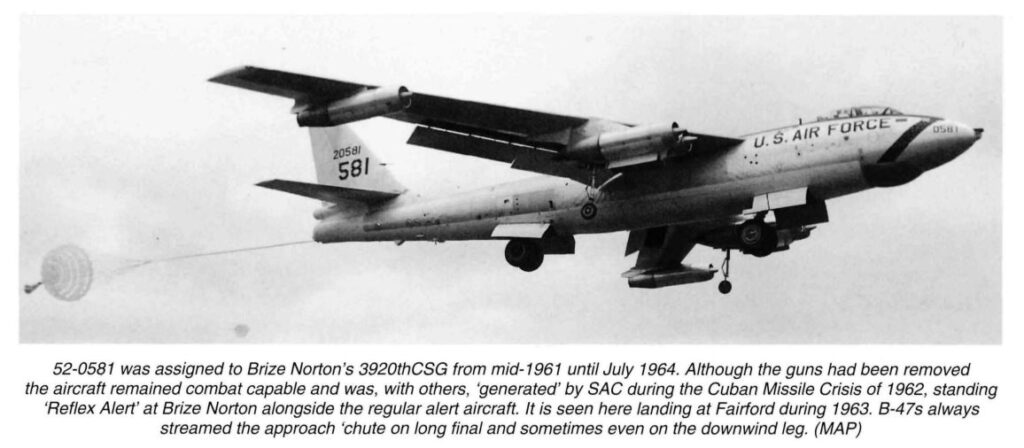
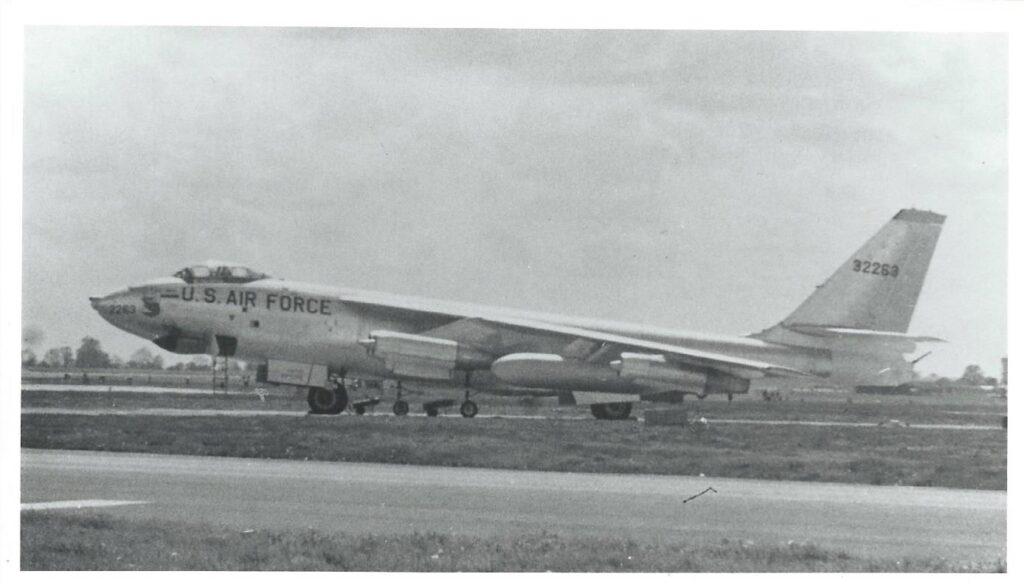
Thanks to Colin Smith
June – The 340th BW eventually terminated its ‘Reflex’ operation on 30th June 1963 and was replaced by the 40th BW from Forbes AFB, KS the following day. Nine aircraft stood this alert with three changing each week. The 40th’s alert continued until 31st March 1964.

1964
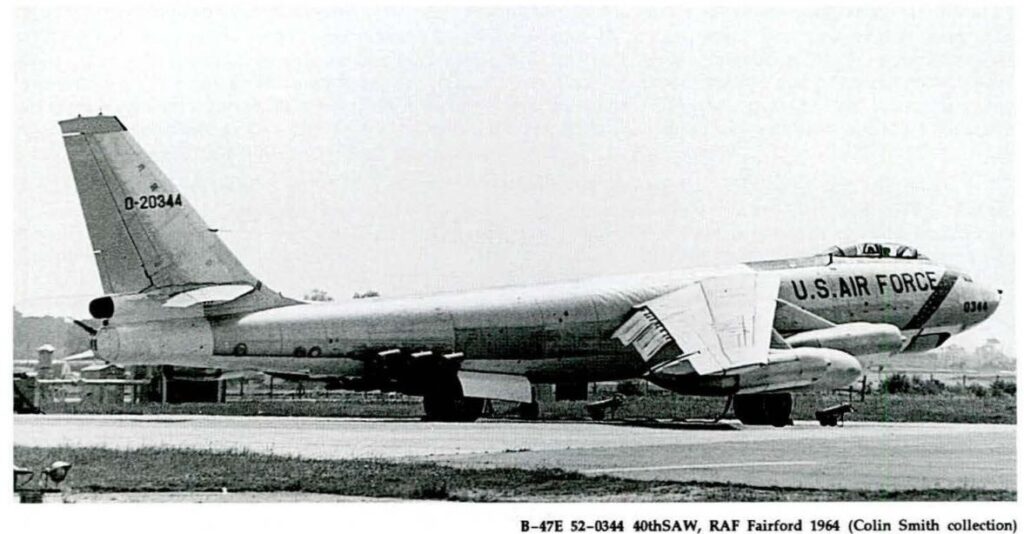
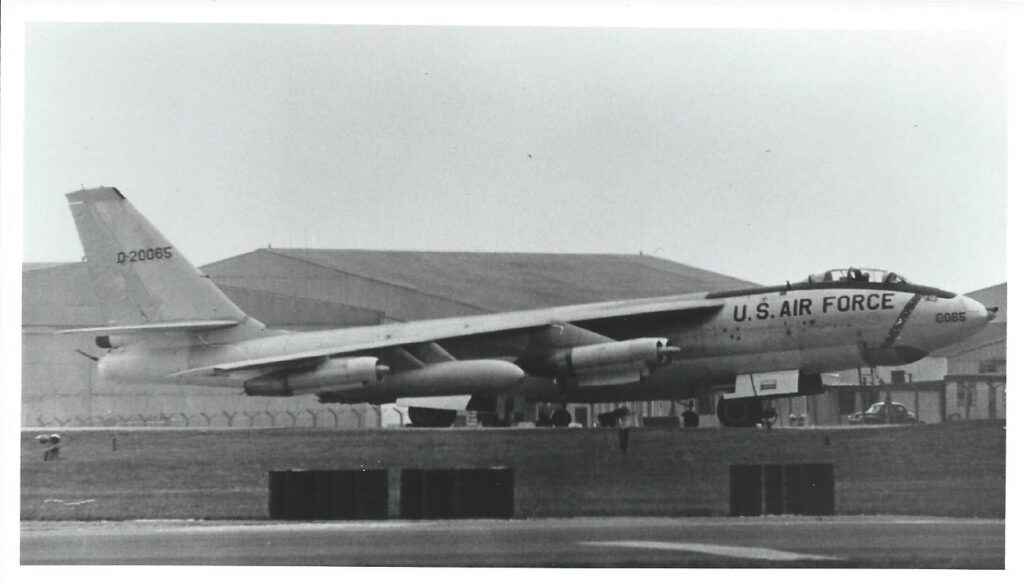
Thanks to Colin Smith
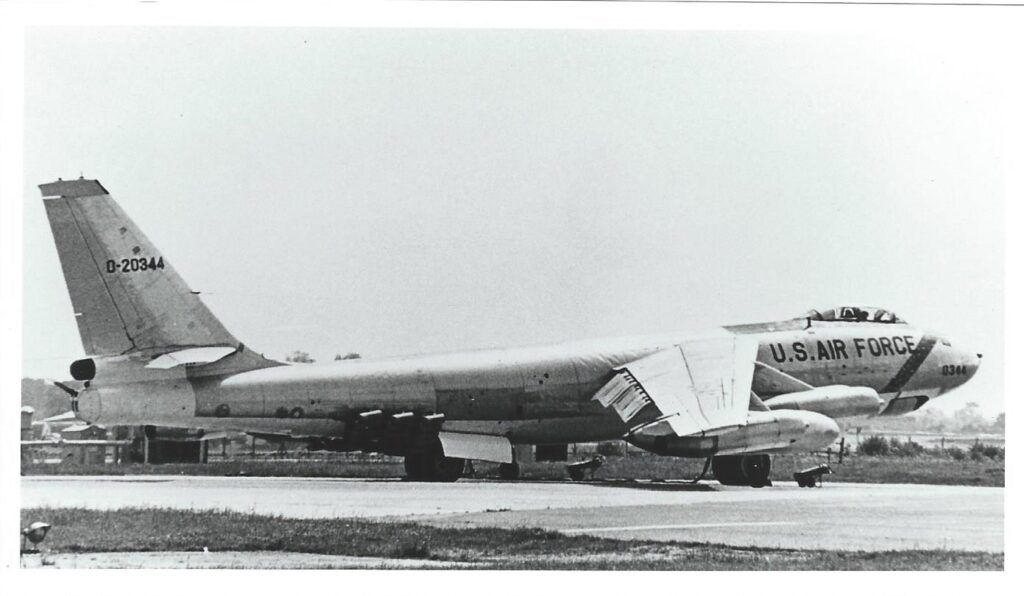
Thanks to Colin Smith
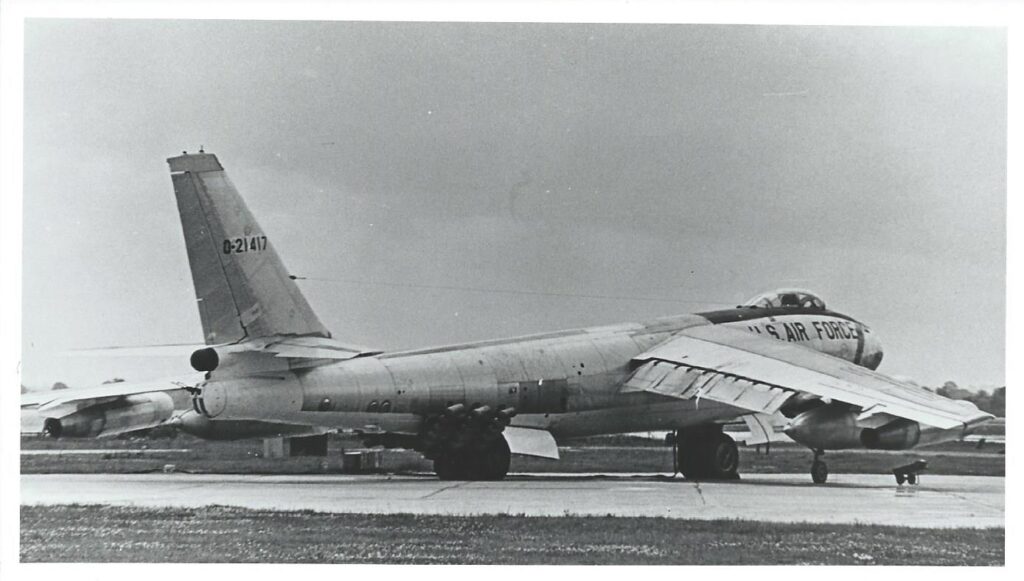
Thanks to Colin Smith
Apr – On the 1st April ten B-47E-IV ‘Blue Cradle’ ECM aircraft flew from Upper Heyford to Fairford to stand alert while the base was closed out. These aircraft were from the 376th BW at Lockbourne and remained on alert at Fairford until 31st May when they all returned to the USA.
June – The base continued to be used by the U.S. Air Force until June 26, 1964, when it was transferred back to RAF control.
Fairford also hosted Detachment 801, 3rd Air Postal Squadron (RAF West Ruislip); Detachment 24, 28th Weather Squadron (RAF Northolt); Detachment 3, 1970th Communications Squadron (RAF Brize Norton)
This page lists units assigned from 1950 – 1964
B-52 Visits
B-52’s were always rare birds at Fairford and very few were recorded before late-1963. It seems likely that Fairford received some kind of B-52 shakedown either during the 92nd BW’s extended visit to Brize Norton during the Spring of 1958 or that of the 6th BW two years later. Two known later visitors were B-52F 57-0052 of the 7th BW (April 1962) and B-52G 58-0185 of the 4241st SW (July 1962). However, during the last year of Fairford’s life as a 7th Air Division Base, the B-52 became a regular visitor with at least a dozen visiting between December 1963 and April 1964. As part of a wider training and familiarisation programme, single aircraft visited the base for long weekends, parking conveniently near to the perimeter fence in the south-east corner. Still in the pre-camouflage era, most aircraft wore wing badges and the SAC sash.
In a leaflet celebrating the 60th Anniversary of RAF Fairford, the following statement was made – ‘In 1962, B-52s made frequent appearances at Fairford’ These are likely to have been part of the ALARM BELL deployments to the UK
December 1963:
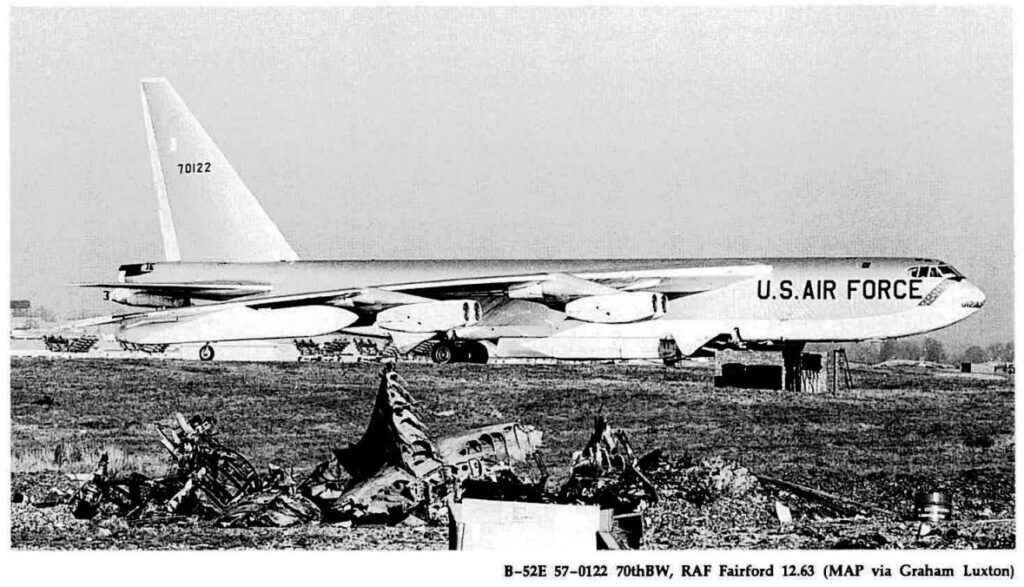
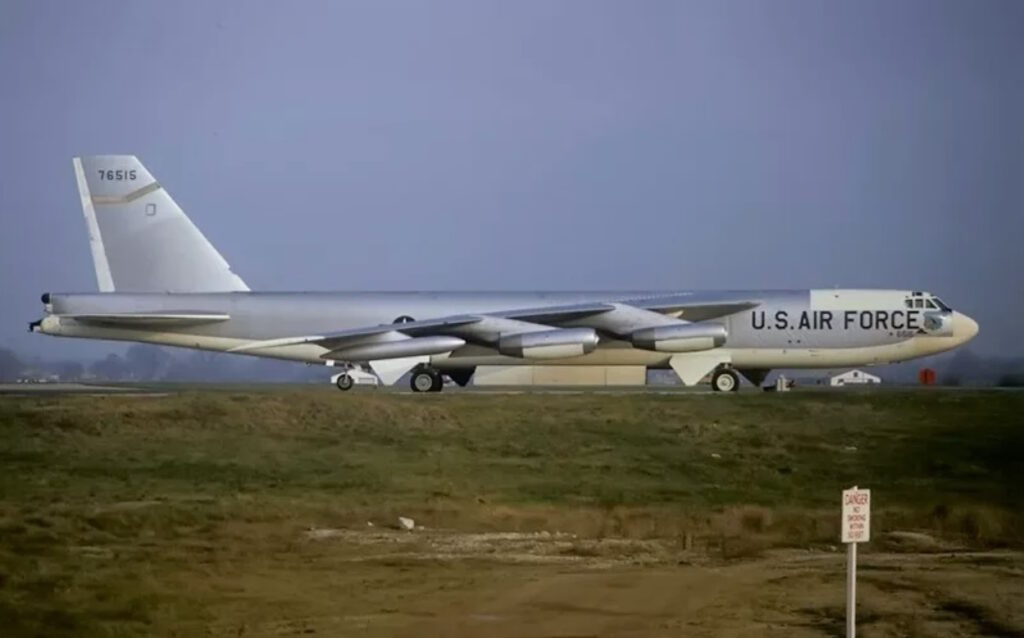
- 55-0061 B-52D 484th BW Turner AFB, CA
- 57-6515 B-52G 456th SAW Beale AFB, CA
- 57-0122 B-52E 70th BW Clinton-Sherman AFB, OK
January 1964:
- 57-0135 B-52F 17th BW Wright-Patterson AFB, OH
February 1964:
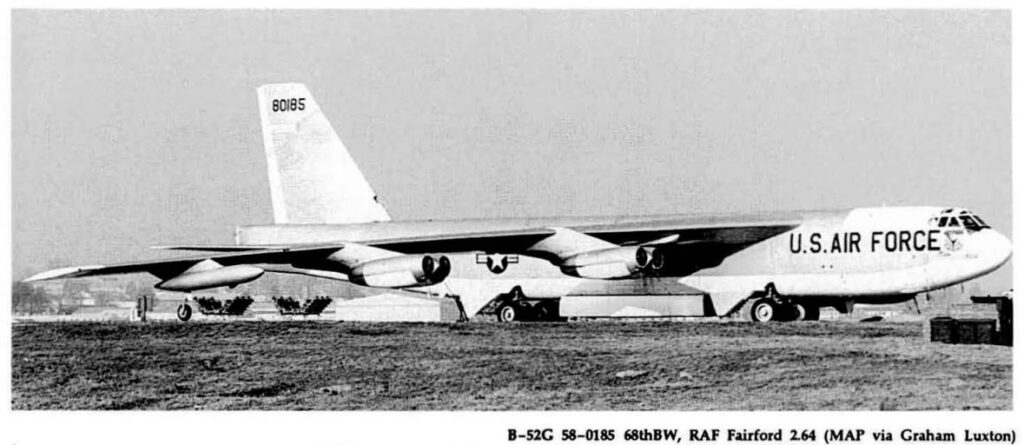
- 58-0185 B-52G 68th BW Seymour-Johnson AFB, NC
- 55-0052 B-52D 306th BW McCoy AFB, FL
- 56-0616 B-52D 461st BW Amarillo AFB, TX
- 57-0046 B-52E 2nd BW Barksdale AFB, LA
March 1964:
- 57-6514 B-52G 97th BW Blytheville AFB, AR
- 61-0010 B-52H 449th BW Kincheloe, MI
- 55-0675 B-52D 28th BW Ellsworth AFB, SD
April 1964:
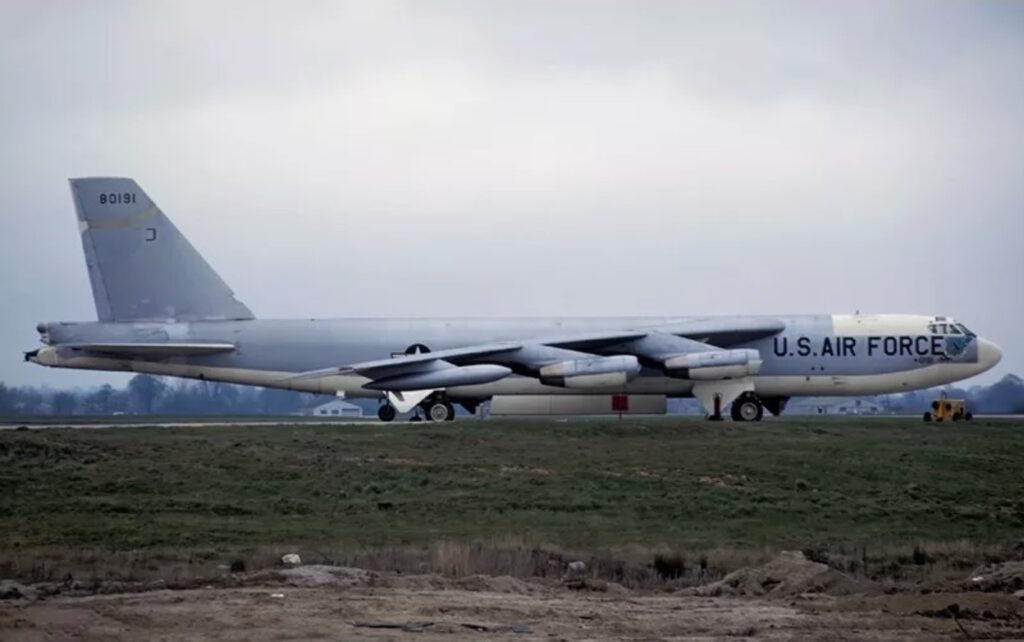
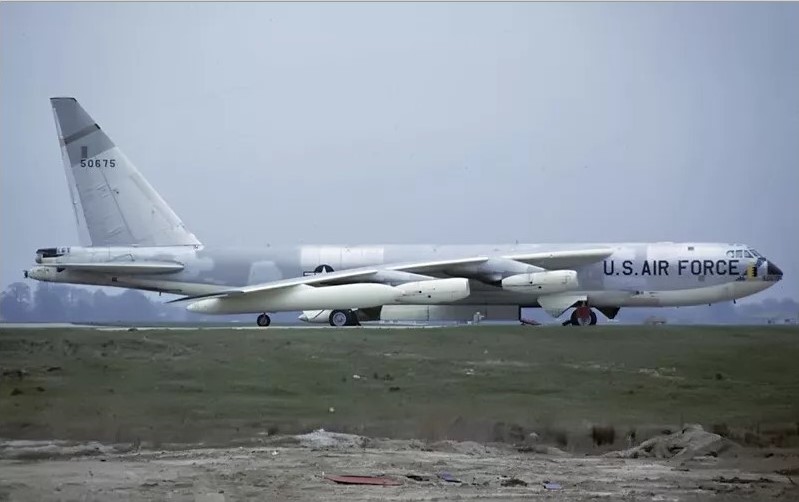
- 58-0191 B-52G 456th SAW Beale AFB, CA
Additional photo’s of B-52’s at RAF Fairford – Most of these will have been taken by Brian Stainer (APN) or Tony Breese (or guys who borrowed their cameras) – Thanks to Colin Smith
Aircraft Accidents & Incidents
06.02.53 51-5719 B-36H, USAF: 492nd BS / 7th BW https://aviation-safety.net/wikibase/152762
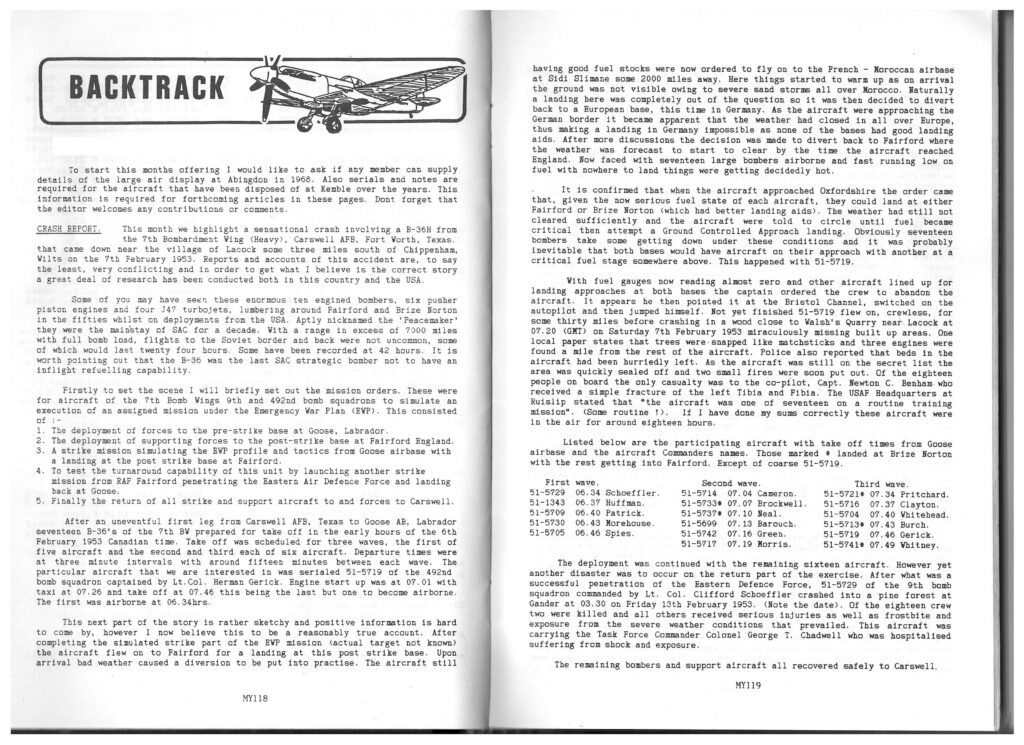
20.07.54 51-17385 B-47E, USAF: 68 BW, Crashed on take-off, Fairford Forgotten Jets
06.08.54 51-2382 B-47E, USAF: 68 BW, Stalled & crashed on take-off, 2m from Fairford https://aviation-safety.net/wikibase/156308
01.05.55 52-0386 B-47E, USAF, Crashed on take-off, Fairford https://aviation-safety.net/wikibase/60607
Other sources used
- ‘RAF Fairford and Strategic Air Command, 1948 to 1964’ Colin Smith / BARG
- ‘Force for Freedom – The USAF in the UK Since 1948’ Michael J. F. Bowyer
- ‘United States Air Force In Britain – Its aircraft, bases and strategy since 1948’ Robert Jackson
- 1984 RAF Fairford Open Day Programme
- ‘Strategic Air Command in the UK – SAC Operations 1946-1992’ Robert S Hopkins III
In March 2001, during reconstruction work on the airfield at Fairford, two wings from a B-47 were dug up. This was on the South East corner of the base. It is almost certain that these are the remains of a B-47E 52-0255. This aircraft was received from ‘305th BW’ in June 1959 as a Ground Instruction Airframe. It was hangered until October 1963, when it was moved to the South East Corner. The aircraft was then broken up, with some parts being buried in situ.
Please contact me at darren@raf-fairford.co.uk should you have any any further information. Thank you

